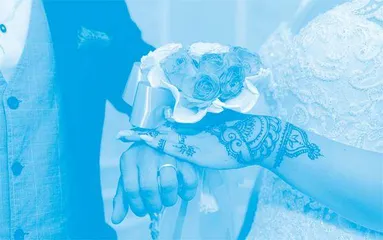Stories on the Skin绘在皮肤上的故事
作者: 施慧静/译

Henna1 designs have cultural as well as personal significance, while the roots of this plant-based dye run deeper than you might think.
海娜纹饰既蕴含文化意义,又极富个人意义,而这种植物染剂的历史之悠久,可能远远超过你的想象。
If you’re connected to certain cultures, especially South Asian and Arabic, you might be used to having intricate floral and geometric patterns painted in fine red or black lines onto your skin. If not, perhaps you’ve seen these beautiful decorations being applied to people’s hands and feet for celebrations or festivals.
如果你拥有特定的文化背景,尤其是来自南亚或者阿拉伯国家,你也许习惯在皮肤上用细细的红色或黑色线条绘上复杂精致的花卉和几何图案。即使没有这样的背景,或许你也在庆典上或节日里见过这种绘在人们手上和脚上的美丽纹饰。
Henna body art might seem like a modern trend, but henna is arguably the oldest cosmetic on the planet, popular for being natural, chemical-free and affordable.
海娜身体艺术或许看起来是一种现代时尚新潮,但海娜染剂可以说是地球上最古老的化妆品,因纯天然、无化学成分、价格亲民而广受青睐。
Look of love
爱的模样
The green henna plant (which is also known as hina, the mignonette tree and the Egyptian privet) is considered a symbol of love, eternal youth and long life. It’s an important feature of wedding ceremonies, especially in South Asia, where it’s called mehndi, and in the Middle East, where it’s known as hana.
人们把绿色的海娜植株(又名合乃、木犀草树或埃及女贞)当成美好爱情、青春不老、长命百岁的象征。绘制海娜纹饰是婚礼庆典上的重要环节,尤其是在南亚和中东。海娜纹饰在南亚叫作“曼海蒂”,而在中东,人们称其为“哈娜”。
In India and Pakistan, henna art has traditionally been an important part of Hindu, Sikh and Muslim weddings, as well as festivals including Diwali, Karva Chauth and Eid.
在印度和巴基斯坦两国,海娜艺术历来是印度教、锡克教以及伊斯兰教婚礼的重要一环,也是印度教排灯节、印度教女人节、伊斯兰教开斋节等节庆活动的重要组成部分。
Mehndi parties are often held before a wedding. The henna is applied with a cone, brush or stick, with intricate patterns over both sides of the arms and feet that can last anything from 10 days to two weeks. The application, which can take as long as six hours, is considered a ritual. Designs might symbolise certain desirable qualities, such as joy, luck and success; and there’s a saying that the darker the colour, the stronger the marriage will be.
曼海蒂聚会一般在婚礼之前举办。人们用锥形颜料管、刷子或细棍在双臂和双脚上绘制复杂精致的海娜纹饰,大致能保持十天到两周。绘制过程可以长达六个小时,过程本身就被人们视作一场仪式。海娜纹饰各有各的特定寓意,比如象征喜悦、幸运和成功。还有一种说法是海娜纹饰的颜色越深,婚姻就越牢固。
Humaira Khan is a freelance henna artist based in West Sussex. She describes how she got into the art: ‘I started in 2008, while I was applying henna on my hands for Eid,’ she says. ‘My mum and friends complimented my designs, and from then on, I decided to perfect my craft.’ Humaira has since been commissioned to apply henna for weddings, birthday parties and other occasions.
霍梅拉汗是一名个体海娜手绘师,住在英格兰的西萨塞克斯郡。她娓娓诉说了自己与海娜艺术结缘的故事。“这得从2008年讲起,当时正值开斋节,我正在双手上绘制海娜纹饰。”她说,“母亲和朋友们都赞美我画的图案,自那时起,我便决定要精进手艺。”从此,霍梅拉受邀为婚礼庆典、生日宴会等重大场合手绘海娜纹饰。
Traditional and modern
传统与现代
As a second-generation Pakistani woman, Humaira has a personal insight into why the practice of applying henna is still relevant to British-based, South Asian brides. ‘As Asian women living in the west, we have an urge to stay linked to our heritage,’ she says. ‘Our identities are always so complex and there’s sometimes a feeling that we belong neither here nor there—henna is one way in which we can fill that hole of longingness [for traditional culture].’
霍梅拉是第二代巴基斯坦裔移民。提到手绘海娜纹饰为何仍对身在英国的南亚裔新娘意义重大,霍梅拉有切身体会。“我们生活在西方的亚洲女性强烈渴望保留自己的文化传统。”她说,“我们的身份一向如此复杂,有时甚至会觉得自己既不属于这个国家,也不属于那个国家,而手绘海娜纹饰可以满足我们(对传统文化)的渴望。”
The long history of henna
海娜的悠久历史
1. The use of mehndi is described in the earliest Hindu Vedic ritual books and henna is thought to have been used for its cooling properties for around 5,000 years.
1. 最早的印度教吠陀礼仪经书中就有关于绘制曼海蒂的描述,人们认为海娜植株用于清热已有大约五千年的历史。
2. Around 3000 years ago, the Assyrians (an ancient civilisation in Mesopotamia in the Middle East) dyed their hair with henna.
2. 大约三千年前,亚述人(中东美索不达米亚地区的古老文明)使用海娜染发。
3. Women in ancient Greece used the dye to colour their eyebrows.
3. 古希腊妇女用海娜染眉。
4. In ancient Egypt, the pharaohs used henna, which is seen in hieroglyphics, on items found in the tomb of Tutankhamun, and the hennaed fingernails of mummies.
4. 古埃及的法老也使用海娜,这一点可见于图坦卡蒙墓中出土物件上的象形文字,以及木乃伊手上由海娜染色的指甲。
5. Egyptian queen Cleopatra enhanced her looks with henna—it was applied to her fingernails and mixed with juniper berries and other plants to colour her famous locks (though histor-ians think that it was her wigs rather than her actual hair that were hennaed).
5. 埃及女王克娄巴特拉曾利用海娜来美容,不但用它染指甲,还将其与杜松子等植物混合,用来给她美得出名的秀发染色(不过,历史学家认为染色的是假发套,而不是她的真发)。
6. The Islamic prophet Muhammad is said to have dyed his beard with henna, igniting a trend among his followers that’s still seen to this day.
6. 相传,伊斯兰教先知穆罕穆德曾用海娜来染胡须,他在其追随者中引领的这股潮流一直延续至今。
7. Germanic warriors used it to transform their golden hair into a fiery red that would make them appear fearsome in battle—a practice that warring Gauls and Anglo-Saxons continued, adding orange and blue dyes.
7. 日耳曼战士用海娜将金发染成血红色,这样就能在战斗中震慑敌人。后来,交战中的高卢人和盎格鲁-撒克逊人沿用了这一做法,他们还把头发染成橙色与蓝色。
8. Modern mehndi has seen a demand for novelty creations, with brides incorporating personal memories or significant emblems into their designs, such as a nod to their favourite football team or the city where they met their partner.